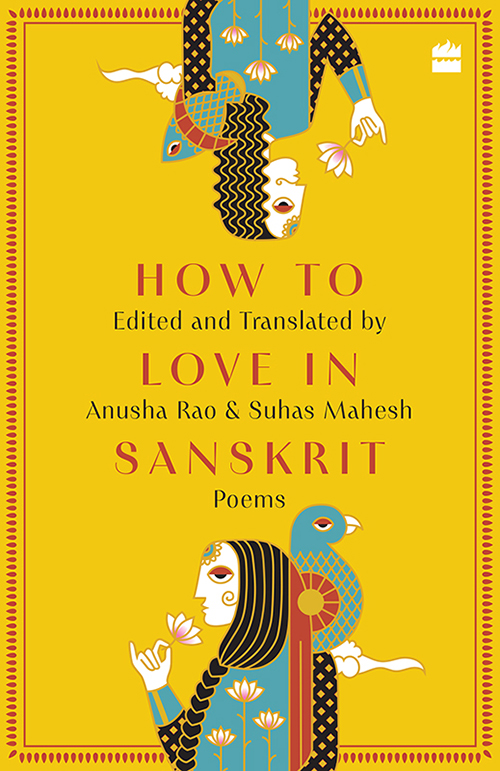← Back to June 2025 Newsletter Contents
Are you nursing a broken heart? Curious about the meaning of your crush’s texts? Or perhaps you just want to tell someone you love them?
In the modern world, there are many places where you can seek advice on matters of the heart. And one of them isn’t modern at all — in fact, it’s well over two thousand years old.
Anusha Sudindra Rao, a PhD candidate in the Department for the Study of Religion, co-wrote a unique romance book last year with her partner, Suhas Mahesh. How to Love in Sanskrit is a compendium of short, exquisite poems divided into chapters with instructive titles such as “How to Flirt,” “How to Yearn,” “How to Daydream,” “How to Break Up” and “How to Let Go.”
Originally written by a wide range of Sanskrit scholars — ancient poets, monks, emperors and even some modern-day writers — the poems were thoughtfully translated by Rao and Mahesh.
“I have lots of friends who’ve asked for recommendations of poetry in Sanskrit,” says Rao. “At first I was hard pressed to name any particular text, because Sanskrit is thought of as a sacred language, a language of the elite. It carries a lot of baggage. So my partner and I decided to do a translation ourselves, and to really choose those poems that can speak to a contemporary audience.

“It’s really surprising how relatable some of the voices in these poems continue to be today. It’s gotten a great reception so far.”
Mahesh, Rao’s partner in life and literature, is a materials physicist and a former Rhodes Scholar who earned his PhD in condensed matter physics from the University of Oxford. He is currently a Schmidt Science Fellow with the Acceleration Consortium.
“But he’s a Sanskritist on the side,” says Rao, “a hobbyist, albeit a serious one.”
Rao is a longtime scholar of Sanskrit, and her doctoral studies are centred on the intellectual history of Vedānta: the set of theological, religious philosophical schools that has come to be synonymous with Indian philosophy today. Her particular research looks at the intersection of poetry and philosophy within this tradition.
And over the years of studying ancient Indian texts, she’s seen how many of the problems that plagued her ancestors are not so different from the problems we all face today.
“One of the things that drew me into the study of Sanskrit was the great epic the Mahābhārata, which happens to be ten times the size of the Iliad and Odyssey combined,” she says. “It’s a fabulous epic, and its claim is that there is nothing that is not in it: anything that concerns human affairs can be found here.”
It’s worth noting that general interest in the Mahābhārata has increased lately. It’s the subject of a popular recent theatrical production, and also a podcast by Arti Dhand, an associate professor in the Department for the Study of Religion.This is largely because its lessons remain relevant, a point Rao has has illustrated for the past five years through her witty and accessible weekly column, “Sans the Sacred,” in Bengaluru’s Deccan Herald. The column explores modern dilemmas — celebrity scandals, marital troubles, adult children’s duties to aging parents — and finds striking parallels in stories of the past.
So much is packed into this small verse — loneliness, acceptance, and the inevitability of loss as a part of the human condition.
In the great ocean
one log meets another
and having met
they drift apart.
Such is our lot.— Anusha Sudindra Rao's favourite verse from the Mahābhārata.
“One of the things that surprised me about writing this column was that it wasn’t difficult at all to find topics. I don’t have to try to make it relevant to today’s times, because it already is.”
Rao and Mahesh have plans for more books that unite the ancient with the modern.
Their next book is tentatively titled Don’t Bore the Gods: How to Pray in Sanskrit. “We’re looking at the many creative kinds of prayer that exist in this treasure trove of literature,” Rao says. “We’re also planning books on how to live, how to be wise, and how to let go.”
Sanskrit is considered a dead language in the sense that in the contemporary world, it is only written, never spoken. It is also the foundational language of the Hindu religion. Rao says that some commentators consider Sanskrit too sacred to be brought into the modern realm. But she thinks that’s a narrow-minded view.
“There are people who don’t want Sanskrit used outside of the boundaries that have been set for it,” she says. “But that’s the risk of trying to do something new, right? You’re always going to have someone who wants to safeguard what is precious. But I think it should also be opened up, so more people know about it.
“Our ancestors were not as limited as we are in trying to restrict it to the sacred domain. For instance, love, as we say in the book, was the overwhelming obsession of Sanskrit poets over the ages. Sanskrit was also the language of literary discourse throughout the subcontinent, and sometimes beyond it. So we really shouldn’t be restricting it to the religious: especially the religious as we understand and define and practice it today.”


